Introduction
As the population ages, the importance of maintaining physical health and independence becomes increasingly paramount. Core strength serves as the foundation for stability, balance, and mobility in older adults, playing a critical role in their overall well-being. Engaging in regular core exercises not only reduces the risk of falls but also empowers seniors to navigate daily activities with confidence and ease.
With innovative approaches to fitness, such as:
- Virtual reality training
- Tailored wellness programs
there is an opportunity for organizations to champion the health of their older employees. By prioritizing core strength, HR Benefits Managers can significantly contribute to enhancing the quality of life for seniors, creating a healthier, more active community that thrives on independence and vitality.
Understanding Core Strength: A Foundation for Senior Fitness
Core strength encompasses the stability and power of the muscles surrounding the abdomen, lower back, hips, and pelvis. For senior individuals, engaging in geriatric core exercises is crucial for developing a strong central body, as it serves a key function in maintaining balance and stability, ultimately lowering the risk of falls and improving overall mobility. Engaging these muscles is crucial for nearly all daily activities—whether it's standing up, walking, or climbing stairs.
A robust center that focuses on geriatric core exercises not only stabilizes the body but also enhances older adults' control over their movements, promoting a more active and independent lifestyle. Recent findings indicate that balance training using innovative methods, such as virtual reality systems, can significantly reduce the fear of falling among elderly individuals, with a reported decrease in the fear of falling score from 22.60±3.27 to 21.90±3.54 in the control group. According to Duque et al., "They reported that fear of falling by elderly adults who experienced falling significantly decreased as a result of balance training using a virtual reality system."
Additionally, the multifactorial fall prevention program introduced in Taiwan acts as an inspiring case study, illustrating that a structured approach to geriatric core exercises can result in a significant decrease in fall occurrence and an improvement in physical function among older adults living in the community. By emphasizing essential strength, HR Benefits Managers can play a crucial role in enabling older adults to live more rewarding and self-sufficient lives.
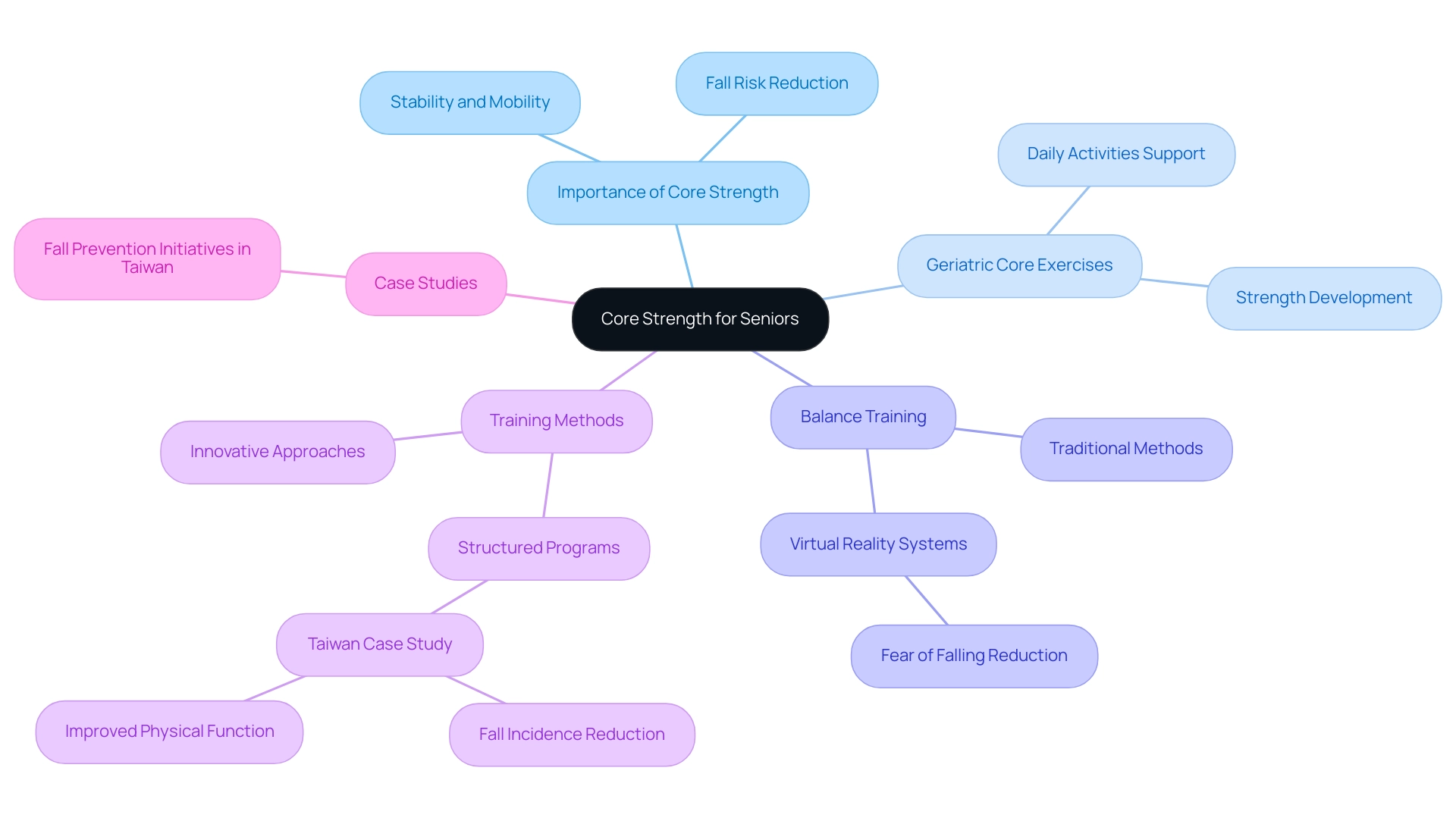
The Benefits of Core Exercises for Seniors: Enhancing Balance and Mobility
Geriatric core exercises are essential for enhancing the well-being of seniors, significantly improving their balance, stability, and posture. Research, including a study by Weston et al. (2013) with a sample size of 36 and an average age of 47, indicates that enhancing stability can notably decrease fall risks—an issue of paramount importance for older adults.
For instance, studies have shown that individuals participating in essential workouts experience a marked reduction in fall rates, ultimately fostering greater independence. Additionally, Gong (2013) investigated correlations between transversus abdominis thickness, lumbar stability, and balance, reinforcing the argument that trunk strength is crucial for maintaining stability. Beyond fall prevention, these activities also relieve lower back discomfort and improve overall mobility, enabling older adults to handle daily tasks with ease.
Consistent involvement in geriatric core exercises and essential workouts not only enhances functional fitness but also improves the quality of life, allowing older adults to sustain active participation in social activities. Significantly, demographic research has demonstrated wide applicability of these findings across various age ranges and competitive tiers, emphasizing the importance of fundamental workouts for seniors. As noted by Dr. Kwon-Young Kang, PhD, PT:
Core muscle stability training should be considered as a therapeutic method for the elderly to improve their WDI and SI, and as a fall prevention measure.
By prioritizing geriatric core exercises, HR Benefits Managers can champion the health of senior adults and facilitate a more active and fulfilling lifestyle.
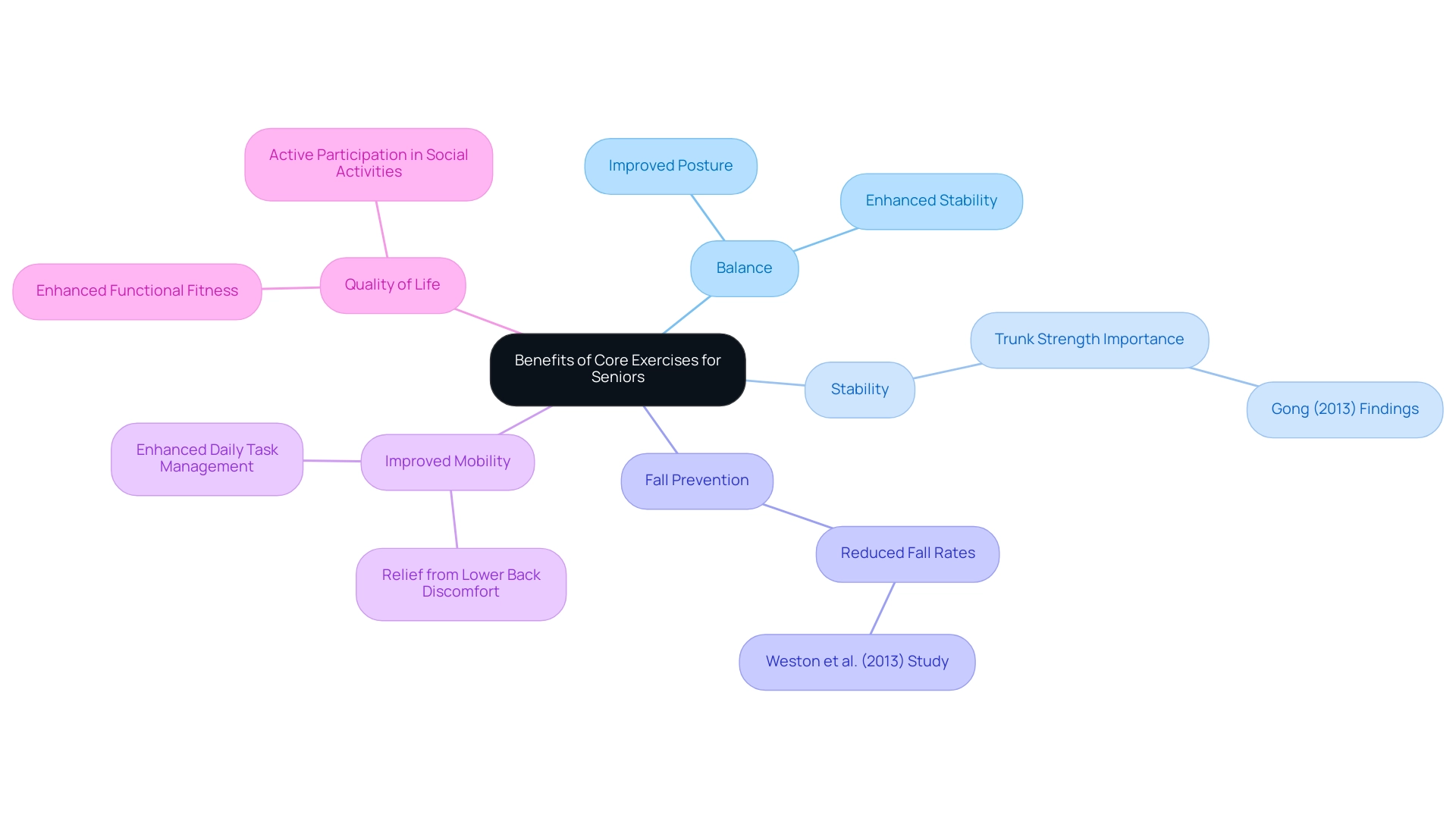
Effective Core Exercises for Seniors: Techniques to Try
To enhance fundamental well-being among older individuals, integrating beneficial activities into daily routines can create a substantial effect. Studies suggest that activating the central muscles can be quantitatively assessed; for instance, a push-up with hands placed at 65 cm from the ground demonstrated EMG activity of around 9.36% MVIC, emphasizing the significance of muscle activation in different workouts. Here are some valuable core exercises that seniors can easily practice:
- Seated Marches: While sitting in a sturdy chair, lift one knee at a time as if marching in place. This straightforward yet efficient exercise not only involves the center of the body but also improves balance, making it an excellent option for maintaining stability.
- Chair Yoga: Embracing the calm of seated yoga poses can work wonders for flexibility and trunk strength. Positions like seated twists and lateral stretches are especially beneficial, enabling older adults to activate their abdominal muscles while encouraging relaxation and mindfulness.
- Bridge Exercise: Lying on their back with knees bent, older adults can lift their hips off the ground, squeezing the glutes and activating the abdominal muscles. Holding this position for a few seconds before lowering helps strengthen the lower back and abdominal muscles, providing foundational stability.
- Standing Side Leg Raises: Standing behind a chair for support, older adults can lift one leg to the side. This activity not only enhances the central muscles but also boosts overall stability and leg strength, crucial for daily tasks.
- Wall Sit: For an effective isometric workout, seniors can stand with their backs against a wall and slide down to a seated position. This exercise activates the midsection while simultaneously strengthening the legs, fostering endurance.
According to Boehm, "We want the central muscles to be short and tight." Tightness will give it stability. But we want the muscles that surround it to be flexible."
This insight highlights the balance required between strength and flexibility in foundational workouts. Moreover, a study by McGill & Marshall (2012) illustrated the efficacy of free-weight activities aimed at core muscles, offering moderate proof of their advantages for senior individuals.
Always remember to begin with a gentle warm-up and consult a healthcare professional before starting any new exercise regimen. Prioritizing these core-strengthening activities can lead to a healthier, more active lifestyle for seniors.
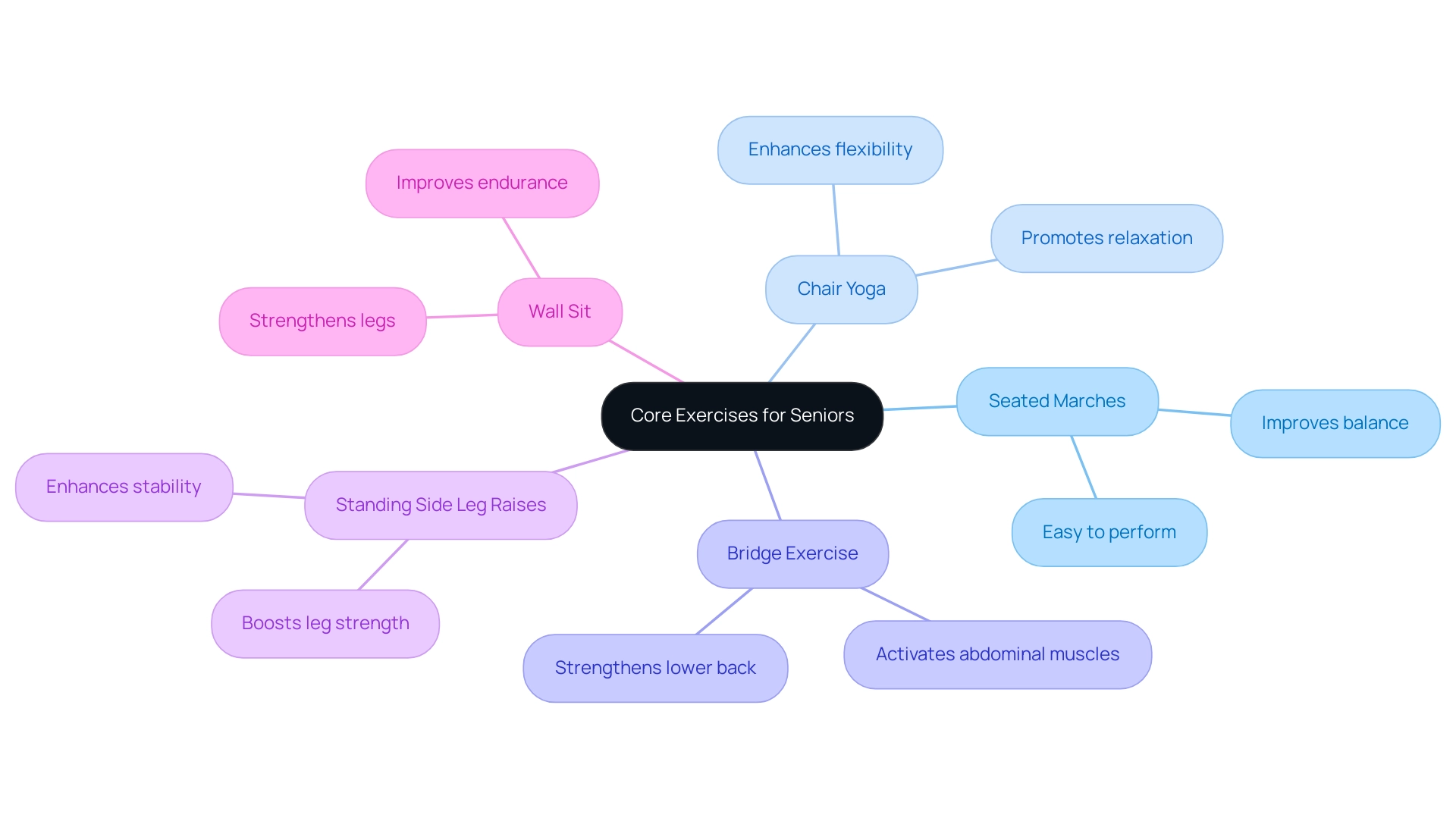
Safety First: Modifications and Precautions for Senior Core Workouts
When encouraging seniors to engage in geriatric core exercises, it's vital to emphasize safety to ensure a positive and effective experience. Research indicates that it is never too late to become fit, and the human body reacts to exercise at any age, making it crucial to encourage older adults to engage in geriatric core exercises. By implementing tailored corporate wellness programs, HR Benefits Managers can enhance the engagement and health of older employees, fostering both productivity and cognitive performance.
These programs can lead to significant benefits for the organization, including reduced absenteeism and lower healthcare costs, creating a healthier workforce and a more robust bottom line.
Here are some essential safety tips to guide seniors:
- Listen to Your Body: It's crucial for seniors to pay attention to their bodies. If any physical activity induces pain or discomfort, they should cease the activity immediately and consult a healthcare professional. This proactive approach fosters a safer activity environment.
- Use Support: For standing exercises, utilizing a chair or wall for support can significantly enhance stability and balance. This simple adjustment can enable older adults to feel more confident in their movements.
- Modify Movements: Exercising should never feel overwhelming. If a particular movement proves too strenuous, encourage older adults to modify it by reducing the range of motion or opting for seated variations. This adaptability can make workouts more enjoyable and accessible.
- Focus on Form: Emphasizing proper technique is essential in preventing injuries. Consider suggesting that older adults collaborate with trainers who specialize in fitness for their age group. As Richard P Troiano states, "Proper exercise modifications are key to ensuring safety and effectiveness in workouts for senior adults." This guidance not only promotes correct form but also enhances their overall workout experience.
- Hydrate: Staying hydrated is a fundamental aspect of health, particularly during physical activity. Remind seniors to drink water before, during, and after their workouts to support their well-being and improve performance.
Moreover, the findings from the case study comparing national surveillance systems highlight substantial differences in physical activity levels among senior adults. This underscores the importance of tailored interventions that take into account the unique needs of this demographic. By applying these safety suggestions and promoting customized wellness programs specifically designed for senior individuals, HR Benefits Managers can motivate their teams to confidently participate in essential workouts, such as geriatric core exercises, knowing they are prioritizing their health and safety while also gaining the organizational advantages.
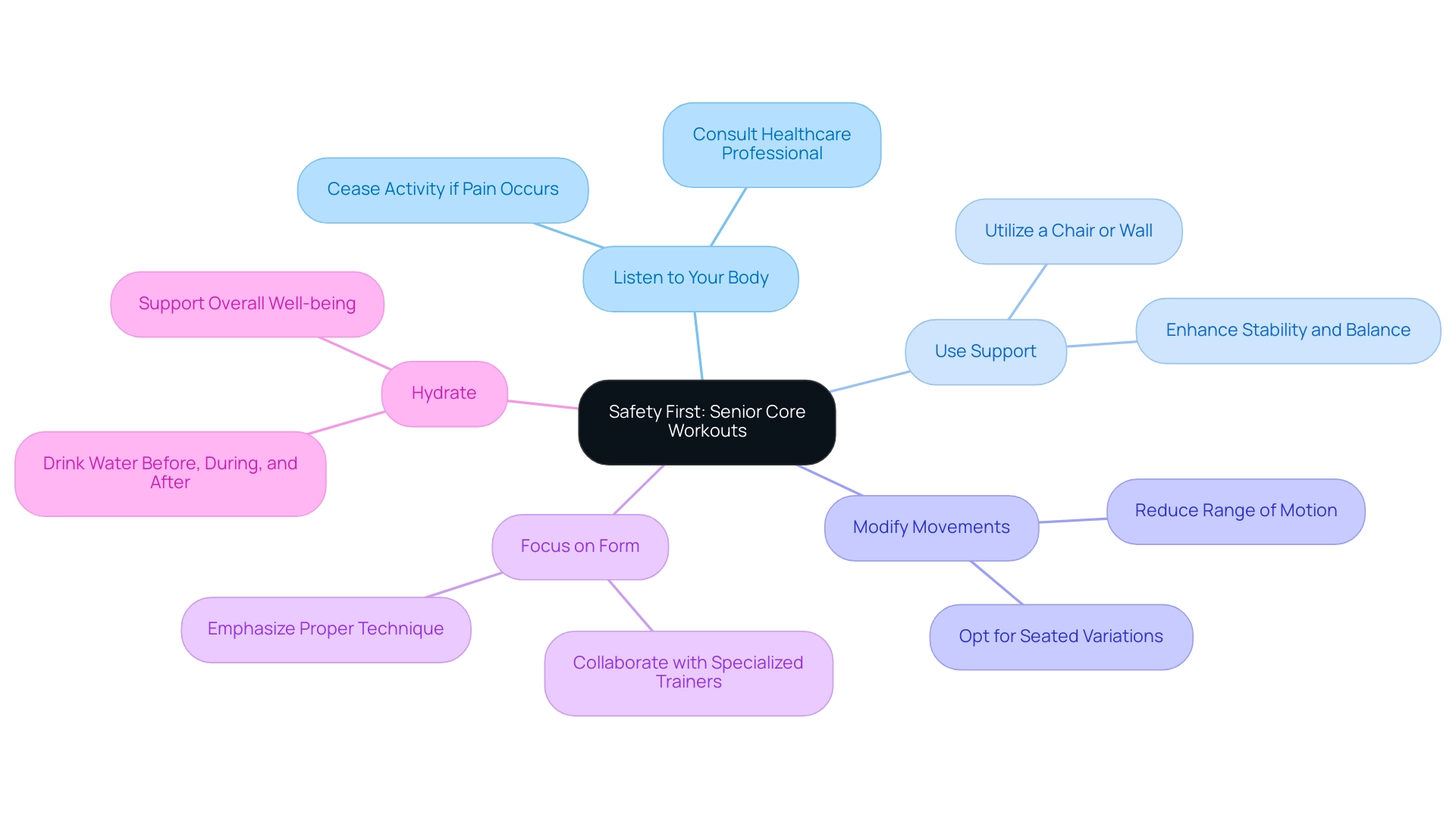
Preventing Falls: The Role of Core Strength in Daily Activities
Geriatric core exercises are essential for sustaining balance and stability, both of which are important in preventing falls among seniors. Participating in regular geriatric core exercises enables seniors to carry out essential daily activities—walking, bending, and reaching—without jeopardizing their stability. Significantly, studies have indicated that seniors who started exercising after experiencing a fall in 2019 were less likely to encounter recurrent falls within the following two years.
This statistic highlights the transformative effect of fundamental training on safety and independence. Furthermore, Namkee G. Choi notes that Hispanic older adults who fell had a higher risk of experiencing recurrent falls compared to their White peers, highlighting the need for targeted interventions. The case study titled "Racial and Ethnic Differences in Fall Risks" emphasizes that demographic factors significantly influence fall risks, suggesting that tailored prevention strategies are essential for different racial and ethnic groups.
Additionally, recent studies indicate that complex fall prevention interventions can effectively reduce fall risks in residential aged care populations, particularly when additional resources are available. By encouraging geriatric core exercises as foundational training, we can help seniors improve their posture and quicken their reflexes, enabling them to respond promptly if they begin to stumble. Incorporating geriatric core exercises into their routines can significantly reduce fall risks, fostering a safer, more active lifestyle that enhances their overall quality of life.
As we consider the latest findings on balance and stability exercises, it becomes clear that encouraging geriatric core exercises is not just beneficial—it's essential for our aging populations.
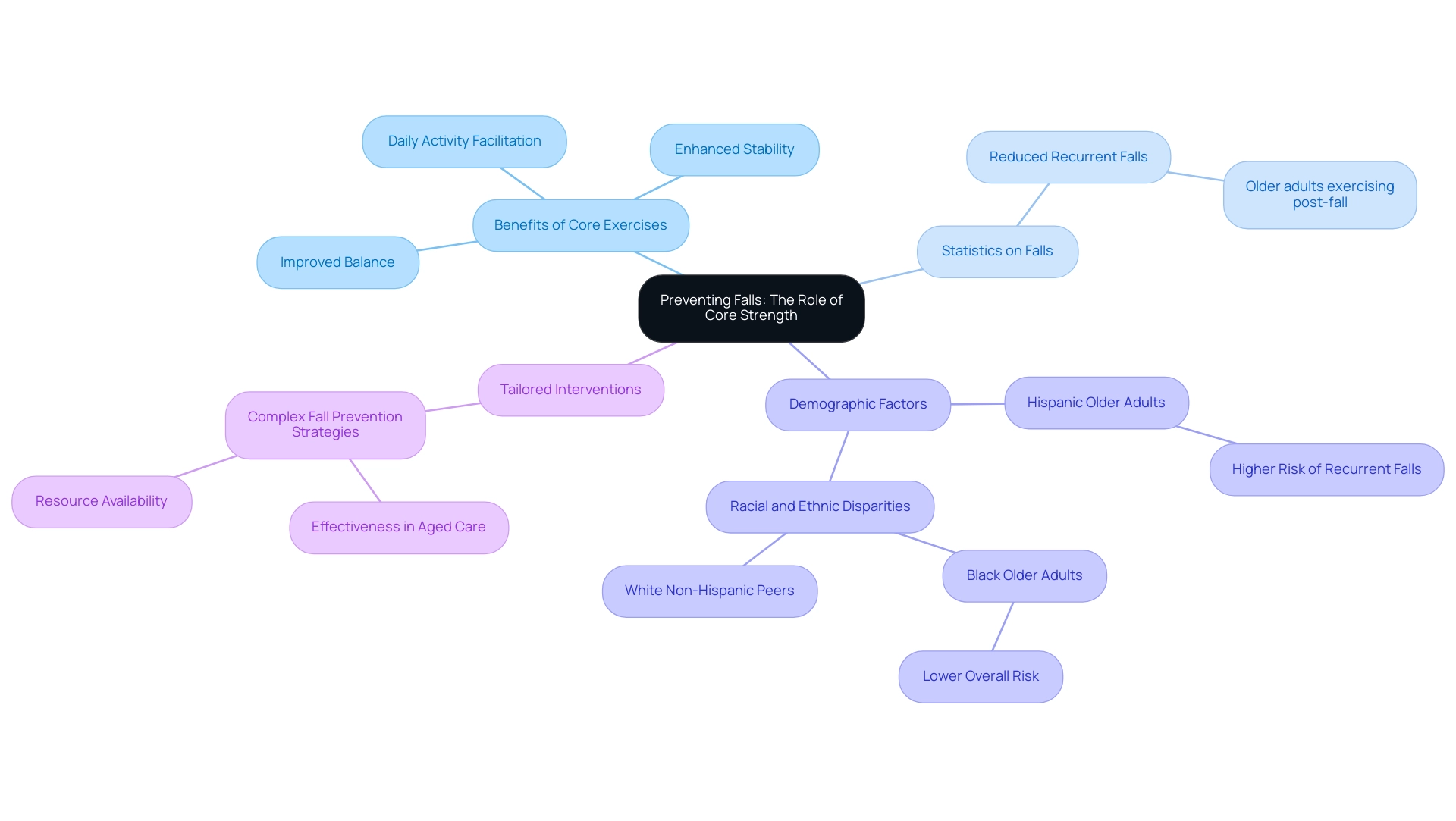
Conclusion
Prioritizing core strength in older adults is not merely a fitness trend; it is a vital component for enhancing their quality of life and independence. By understanding the significance of core stability, HR Benefits Managers can play an instrumental role in implementing tailored wellness programs that address the unique needs of seniors. Engaging in core exercises fosters better balance, reduces the risk of falls, and empowers older adults to navigate daily activities with confidence.
The research highlights the transformative impact of core training, demonstrating its effectiveness in improving mobility and reducing fall incidence. Simple yet effective exercises, such as:
- Seated marches
- Bridge workouts
can easily be integrated into daily routines, ensuring seniors remain active and engaged. However, safety must always be a priority; encouraging modifications and proper techniques will create a supportive environment for older adults to thrive.
Ultimately, investing in core strength for seniors not only enhances individual health but also contributes to a more vibrant and productive workplace. By championing these initiatives, organizations can cultivate a culture of wellness that benefits everyone involved. Now is the time to take action—embracing core strength as a fundamental aspect of senior health is an opportunity to empower older adults and foster a community that thrives on independence and vitality.
Frequently Asked Questions
What is core strength and why is it important for seniors?
Core strength refers to the stability and power of the muscles surrounding the abdomen, lower back, hips, and pelvis. For seniors, developing a strong core is crucial for maintaining balance and stability, which helps lower the risk of falls and improve overall mobility.
How do geriatric core exercises benefit older adults?
Geriatric core exercises enhance balance, stability, and posture in older adults. They help stabilize the body, improve control over movements, and promote a more active and independent lifestyle.
What recent findings support the effectiveness of balance training for seniors?
Recent findings indicate that balance training using innovative methods, such as virtual reality systems, can significantly reduce the fear of falling among elderly individuals. A study reported a decrease in the fear of falling score among participants who underwent balance training.
Can you provide an example of a successful fall prevention program?
The multifactorial fall prevention program introduced in Taiwan serves as a case study, demonstrating that a structured approach to geriatric core exercises can lead to a significant decrease in fall occurrences and improve physical function among older adults in the community.
What research supports the link between core strength and fall prevention?
Research, including a study by Weston et al. (2013), indicates that enhancing stability through core exercises can notably decrease fall risks in older adults. Additionally, studies have shown that those participating in essential workouts experience reduced fall rates and improved independence.
How do core exercises affect daily activities for seniors?
Consistent involvement in geriatric core exercises alleviates lower back discomfort, improves overall mobility, and enables older adults to perform daily tasks with greater ease.
What role can HR Benefits Managers play in promoting core exercises for seniors?
HR Benefits Managers can prioritize geriatric core exercises to champion the health of senior adults, facilitating a more active and fulfilling lifestyle while addressing fall prevention and functional fitness.

